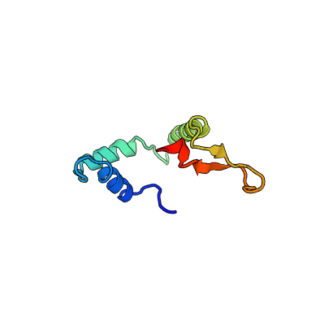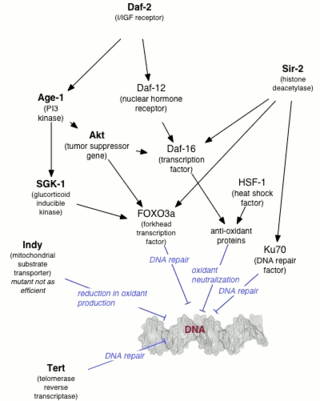Related Research Articles

Caenorhabditis elegans is a free-living transparent nematode about 1 mm in length that lives in temperate soil environments. It is the type species of its genus. The name is a blend of the Greek caeno- (recent), rhabditis (rod-like) and Latin elegans (elegant). In 1900, Maupas initially named it Rhabditides elegans. Osche placed it in the subgenus Caenorhabditis in 1952, and in 1955, Dougherty raised Caenorhabditis to the status of genus.
The DAF-2 gene encodes for the insulin-like growth factor 1 (IGF-1) receptor in the worm Caenorhabditis elegans. DAF-2 is part of the first metabolic pathway discovered to regulate the rate of aging. DAF-2 is also known to regulate reproductive development, resistance to oxidative stress, thermotolerance, resistance to hypoxia, and resistance to bacterial pathogens. Mutations in DAF-2 and also Age-1 have been shown by Cynthia Kenyon to double the lifespan of the worms. In a 2007 episode of WNYC’s Radiolab, Kenyon called DAF-2 "the grim reaper gene.”
Dauer describes an alternative developmental stage of nematode worms, particularly rhabditids including Caenorhabditis elegans, whereby the larva goes into a type of stasis and can survive harsh conditions. Since the entrance of the dauer stage is dependent on environmental cues, it represents a classic and well studied example of polyphenism. The dauer state is given other names in the various types of nematodes such as ‘diapause’ or ‘hypobiosis’, but since the C. elegans nematode has become the most studied nematode, the term ‘dauer stage’ or 'dauer larvae' is becoming universally recognised when referring to this state in other free-living nematodes. The dauer stage is also considered to be equivalent to the infective stage of parasitic nematode larvae.
Leonard Pershing Guarente is an American biologist best known for his research on life span extension in the budding yeast Saccharomyces cerevisiae, roundworms, and mice. He is a Novartis Professor of Biology at the Massachusetts Institute of Technology.
Caenorhabditis briggsae is a small nematode, closely related to Caenorhabditis elegans. The differences between the two species are subtle. The male tail in C. briggsae has a slightly different morphology from C. elegans. Other differences include changes in vulval precursor competence and the placement of the excretory duct opening. C. briggsae is frequently used to study the differences between it and the more intimately understood C. elegans, especially at the DNA and protein sequence level. Several mutant strains of C. briggsae have also been isolated that facilitate genetic analysis of this organism. C. briggsae, like C. elegans, is a hermaphrodite. The genome sequence for C. briggsae was determined in 2003.

Cynthia Jane Kenyon is an American molecular biologist and biogerontologist known for her genetic dissection of aging in a widely used model organism, the roundworm Caenorhabditis elegans. She is the vice president of aging research at Calico Research Labs, and emeritus professor of biochemistry and biophysics at the University of California, San Francisco (UCSF).

Most animal testing involves invertebrates, especially Drosophila melanogaster, a fruit fly, and Caenorhabditis elegans, a nematode. These animals offer scientists many advantages over vertebrates, including their short life cycle, simple anatomy and the ease with which large numbers of individuals may be studied. Invertebrates are often cost-effective, as thousands of flies or nematodes can be housed in a single room.
Barbara J. Meyer is a biologist and genetist, noted for her pioneering research on lambda phage, a virus that infects bacteria; discovery of the master control gene involved in sex determination; and studies of gene regulation, particularly dosage compensation. Meyer's work has revealed mechanisms of sex determination and dosage compensation—that balance X-chromosome gene expression between the sexes in Caenorhabditis elegans that continue to serve as the foundation of diverse areas of study on chromosome structure and function today.
Gary Bruce Ruvkun is an American molecular biologist at Massachusetts General Hospital and professor of genetics at Harvard Medical School in Boston. Ruvkun discovered the mechanism by which lin-4, the first microRNA (miRNA) discovered by Victor Ambros, regulates the translation of target messenger RNAs via imperfect base-pairing to those targets, and discovered the second miRNA, let-7, and that it is conserved across animal phylogeny, including in humans. These miRNA discoveries revealed a new world of RNA regulation at an unprecedented small size scale, and the mechanism of that regulation. Ruvkun also discovered many features of insulin-like signaling in the regulation of aging and metabolism. He was elected a Member of the American Philosophical Society in 2019.

DAF-16 is the sole ortholog of the FOXO family of transcription factors in the nematode Caenorhabditis elegans. It is responsible for activating genes involved in longevity, lipogenesis, heat shock survival and oxidative stress responses. It also protects C.elegans during food deprivation, causing it to transform into a hibernation - like state, known as a Dauer. DAF-16 is notable for being the primary transcription factor required for the profound lifespan extension observed upon mutation of the insulin-like receptor DAF-2. The gene has played a large role in research into longevity and the insulin signalling pathway as it is located in C. elegans, a successful ageing model organism.

Genetics of aging is generally concerned with life extension associated with genetic alterations, rather than with accelerated aging diseases leading to reduction in lifespan.
Judith Kimble is a Henry Vilas Professor of Biochemistry, Molecular Biology, Medical Genetics and Cell and Regenerative Biology at the University of Wisconsin–Madison and Investigator with the Howard Hughes Medical Institute (HHMI). Kimble’s research focuses on the molecular regulation of animal development.

Julie Ann Ahringer is an American/British Professor of Genetics and Genomics, Director of the Gurdon Institute and a member of the Department of Genetics at the University of Cambridge. She leads a research lab investigating the control of gene expression.
WormBase is an online biological database about the biology and genome of the nematode model organism Caenorhabditis elegans and contains information about other related nematodes. WormBase is used by the C. elegans research community both as an information resource and as a place to publish and distribute their results. The database is regularly updated with new versions being released every two months. WormBase is one of the organizations participating in the Generic Model Organism Database (GMOD) project.

Caenorhabditis elegans- microbe interactions are defined as any interaction that encompasses the association with microbes that temporarily or permanently live in or on the nematode C. elegans. The microbes can engage in a commensal, mutualistic or pathogenic interaction with the host. These include bacterial, viral, unicellular eukaryotic, and fungal interactions. In nature C. elegans harbours a diverse set of microbes. In contrast, C. elegans strains that are cultivated in laboratories for research purposes have lost the natural associated microbial communities and are commonly maintained on a single bacterial strain, Escherichia coli OP50. However, E. coli OP50 does not allow for reverse genetic screens because RNAi libraries have only been generated in strain HT115. This limits the ability to study bacterial effects on host phenotypes. The host microbe interactions of C. elegans are closely studied because of their orthologs in humans. Therefore, the better we understand the host interactions of C. elegans the better we can understand the host interactions within the human body.
The DAF-12 gene encodes the nuclear receptor of dafachronic acid in the worm Caenorhabditis elegans, with the NRNC Symbol NR1J1 as the homolog of nuclear hormone receptor HR96 in Drosophila melanogaster. DAF-12 has been implicated by Cynthia Kenyon and colleagues in the formation of Dauer larva.
The Daf-9 gene encodes a cytochrome p450 enzyme catalysis the generation of dafachronic acid in the worm Caenorhabditis elegans, with the CYP Symbol CYP22A1. After generation, dafachronic acid will binding it's nuclear receptor Daf-12 and has been implicated by Cynthia Kenyon and colleagues related to the formation of Dauer larva.
The Dod-13 gene in the worm Caenorhabditis elegans encoding a cytochrome p450 enzyme, which have steroid hydroxylase activity, with the CYP Symbol CYP35B1. Dod-13 is downstream gene of Daf-16 influenced the lifespan of C. elegans.

Collin Yvès Ewald is a Swiss scientist investigating the molecular mechanisms of healthy aging. He is a molecular biologist and a professor at ETH Zurich, where he leads the Laboratory of Extracellular Matrix Regeneration. His research focuses on the remodeling of the extracellular matrix during aging and upon longevity interventions.

The age-1 gene is located on chromosome 2 in C.elegans. It gained attention in 1983 for its ability to induce long-lived C. elegans mutants. The age-1 mutant, first identified by Michael Klass, was reported to extend mean lifespan by over 50% at 25 °C when compared to the wild type worm (N2) in 1987 by Johnson et al. Development, metabolism, lifespan, among other processes have been associated with age-1 expression. The age-1 gene is known to share a genetic pathway with daf-2 gene that regulates lifespan in worms. Additionally, both age-1 and daf-2 mutants are dependent on daf-16 and daf-18 genes to promote lifespan extension.
References
- ↑ "Glenn Laboratories For Aging Research - Lewis-Sigler Institute". Princeton University. Archived from the original on 7 January 2023. Retrieved 9 October 2018.
- ↑ "Coleen T. Murphy, Ph.D. CV" (PDF). Princeton University. Retrieved 9 October 2018.
- ↑ Murphy, C.T.; McCarroll, S.A.; Bargmann, C.I; Fraser, A.; Kamath, R.S.; Ahringer, J.; Li, H.; Kenyon, C. (2003). "Genes that act downstream of DAF-16 to influence the lifespan of Caenorhabditis elegans". Nature. 424 (6946): 277–283. Bibcode:2003Natur.424..277M. doi:10.1038/nature01789. PMID 12845331. S2CID 4424249.
- ↑ "Creative Minds: The Worm Tissue-ome Teaches Developmental Biology for Us All". National Institutes of Health. 17 November 2016. Retrieved 9 October 2018.
- ↑ "Coleen Murphy receives NIH Pioneer Award". Princeton University. Archived from the original on 7 January 2023. Retrieved 9 October 2018.
- ↑ "Coleen Murphy selected as HHMI-Simons Faculty Scholar | Lewis-Sigler Institute". lsi.princeton.edu. Archived from the original on 2023-01-07. Retrieved 2020-09-26.